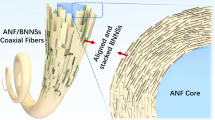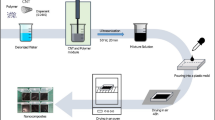Abstract
Carbon nanotube (CNT) fillers in composite materials improve electrical conductivity, thermal stability, and mechanical properties. Boron nitride (BN) is an insulating material that is also thermally stable. Therefore, CNT and hexagonal boron nitride (hBN) fillers have been used to obtain composite materials’ high electrical conductivity. In this study, CNT-hBN/polyacrylonitrile (PAN) fibers were spun using simple wet-spinning and the effect of hBN on the electrical conductivity of the CNT-hBN/PAN composite was investigated. Contrary to predictions, as the content of the insulating material, BN, increased up to 15 wt%, the electrical resistance of the composite fiber decreased.
Similar content being viewed by others
References
A. Eatemadi et al., Carbon nanotubes: properties, synthesis, purification, and medical applications, Nanoscale Research Letters, 9(1) (2014) 1–13.
D. Ürk et al., Understanding the polymer type and CNT orientation effect on the dynamic mechanical properties of high volume fraction CNT polymer nanocomposites, Composite Structures, 155 (2016) 255–262.
B. Arash, H. S. Park and T. Rabczuk, Tensile fracture behavior of short carbon nanotube reinforced polymer composites: a coarse-grained model, Composite Structures, 134 (2015) 981–988.
X. He et al., Large amplitude vibration of fractionally damped viscoelastic CNTs/fiber/polymer multiscale composite beams, Composite Structures, 131 (2015) 1111–1123.
S. Han et al., Mechanical and electrical properties of graphene and carbon nanotube reinforced epoxy adhesives: experimental and numerical analysis, Composites Part A: Applied Science and Manufacturing, 120 (2019) 116–126.
L. Yang et al., Thermal resistant, mechanical and electrical properties of a novel ultrahigh-content randomly-oriented CNTs reinforced SiC matrix composite-sheet, Composites Part B: Engineering, 119 (2017) 10–17.
A. S. Wu and T.-W. Chou, Carbon nanotube fibers for advanced composites, Materials Today, 15(7–8) (2012) 302–310.
Y. Wang and G. J. Weng, Chapter 4. Electrical conductivity of carbon nanotube-and graphene-based nanocomposites, Micromechanics and Nanomechanics of Composite Solids, Springer (2018) 123–156.
A. Nasiri et al., Effect of CNT structures on thermal conductivity and stability of nanofluid, International Journal of Heat and Mass Transfer, 55(5–6) (2012) 1529–1535.
A. A. Balandin, Thermal properties of graphene and nanostructured carbon materials, Nature Materials, 10(8) (2011) 569–581.
J. Yu et al., Tribological properties of epoxy composite coatings reinforced with functionalized C-BN and H-BN nanofillers, Applied Surface Science, 434 (2018) 1311–1320.
H. Shen et al., Bioinspired modification of h-BN for high thermal conductive composite films with aligned structure, ACS Applied Materials and Interfaces, 7(10) (2015) 5701–5708.
O.-K. Park et al., Hexagonal boron nitride-carbon nanotube hybrid network structure for enhanced thermal, mechanical and electrical properties of polyimide nanocomposites, Composites Science and Technology, 188 (2020) 107977.
A. Chaurasia et al., Experimental and computational studies to analyze the effect of h-BN nanosheets on mechanical behavior of h-BN/polyethylene nanocomposites, The Journal of Physical Chemistry C, 123(32) (2019) 20059–20070.
T. Zhang et al., Nacre-inspired polymer composites with high thermal conductivity and enhanced mechanical strength, Composites Part A: Applied Science and Manufacturing, 121 (2019) 92–99.
N. Izyumskaya et al., Recent development of boron nitride towards electronic applications, Advanced Electronic Materials, 3(5) (2017) 1600485.
J. Wang et al., Electrical properties and applications of graphene, hexagonal boron nitride (h-BN), and graphene/h-BN heterostructures, Materials Today Physics, 2 (2017) 6–34.
N. Karunagaran and A. Rajadurai, Effect of surface treatment on mechanical properties of glass fiber/stainless steel wire mesh reinforced epoxy hybrid composites, Journal of Mechanical Science and Technology, 30(6) (2016) 2475–2482.
A. Ali et al., Experimental and numerical characterization of mechanical properties of carbon/jute fabric reinforced epoxy hybrid composites, Journal of Mechanical Science and Technology, 33(9) (2019) 4217–4226.
M. Ahmadi, R. Ansari and H. Rouhi, Multi-scale bending, buckling and vibration analyses of carbon fiber/carbon nanotube-reinforced polymer nanocomposite plates with various shapes, Physica E: Low-Dimensional Systems and Nanostructures, 93 (2017) 17–25.
M. Ahmadi, R. Ansari and H. Rouhi, Free and forced vibration analysis of rectangular/circular/annular plates made of carbon fiber-carbon nanotube-polymer hybrid composites, Science and Engineering of Composite Materials, 26(1) (2019) 70–76.
B. Hu et al., Enhanced thermal conductivity by constructing 3D-networks in poly (vinylidene fluoride) composites via positively charged hexagonal boron nitride and silica coated carbon nanotubes, Composites Part A: Applied Science and Manufacturing, 137 (2020) 106038.
P. Zhang et al., Segregated double network enabled effective electromagnetic shielding composites with extraordinary electrical insulation and thermal conductivity, Composites Part A: Applied Science and Manufacturing, 117 (2019) 56–64.
Y.-J. Xiao et al., Largely enhanced thermal conductivity and high dielectric constant of poly (vinylidene fluoride)/boron nitride composites achieved by adding a few carbon nanotubes, The Journal of Physical Chemistry C, 120(12) (2016) 6344–6355.
J. Che et al., Largely enhanced thermal conductivity of HDPE/boron nitride/carbon nanotubes ternary composites via filler network-network synergy and orientation, Composites Part A: Applied Science and Manufacturing, 112 (2018) 32–39.
B. A. Newcomb et al., Processing, structure, and properties of gel spun PAN and PAN/CNT fibers and gel spun PAN based carbon fibers, Polymer Engineering and Science, 55(11) (2015) 2603–2614.
L. Tan et al., Investigating the spinnability in the dry-jet wet spinning of PAN precursor fiber, Journal of Applied Polymer Science, 110(4) (2008) 1997–2000.
A. K. Naskar et al., UV assisted stabilization routes for carbon fiber precursors produced from melt-processible polyacrylonitrile terpolymer, Carbon, 43(5) (2005) 1065–1072.
M. A. Al Faruque et al., Impact of the wet spinning parameters on the alpaca-based polyacrylonitrile composite fibers: Morphology and enhanced mechanical properties study, Journal of Applied Polymer Science, 137(41) (2020) 49264.
D. Paul, Diffusion during the coagulation step of wet-spinning, Journal of Applied Polymer Science, 12(3) (1968) 383–402.
J.-H. Kim et al., Effect of multi-walled carbon nanotube on rheological behavior and compressive strength of cement paste, Journal of the Korean Recycled Construction Resources Institute, 8(4) (2020) 467–474.
H. Yang et al., Low temperature self-densification of high strength bulk hexagonal boron nitride, Nature Communications, 10(1) (2019) 1–9.
J. S. Lewis et al., Thermal and electrical conductivity control in hybrid composites with graphene and boron nitride fillers, Materials Research Express, 6(8) (2019) 085325.
J. Wang et al., Enhancing the electrical conductivity of PP/CNT nanocomposites through crystal-induced volume exclusion effect with a slow cooling rate, Composites Part B: Engineering, 183 (2020) 107663.
M. Marcourt et al., High impact polystyrene/CNT nanocomposites: application of volume segregation strategy and behavior under extensional deformation, Polymer, 157 (2018) 156–165.
Acknowledgments
This work was supported by the Korea Institute of Science and Technology’s internal research program (2Z06551).
Author information
Authors and Affiliations
Corresponding authors
Additional information
Heejin Kim is a Ph.D. candidate of Korea Institute of Science and Technology, Jeonbuk, Korea. Her research interests include filament for additive manufacturing and fiber reinforced composite for high temperature.
Dae-young Jeon is a Senior Researcher of the Korea Institute of Science and Technology, Jeonbuk, Korea. He received his Ph.D. in Electrical Engineering from Korea University. His research interests include Interfacial characteristics and defect analysis of nanocomposite materials through impedance analysis with equivalent circuit modeling.
Se Gyu Jang is a Principal Researcher of the Korea Institute of Science and Technology, Jeonbuk, Korea. He received his Ph.D. in Chemical Engineering from KAIST University. His research interests include interfacial engineering of polymer/inorganic nanoparticle composites.
Min Wook Lee is a Senior Researcher of the Korea Institute of Science and Technology, Jeonbuk, Korea. He received his Ph.D. in Mechanical Engineering from Korea University. His research interests include functional/structural fiber reinforced composite.
Rights and permissions
About this article
Cite this article
Kim, H., Jeon, DY., Jang, S.G. et al. Synergetic effect of BN for the electrical conductivity of CNT/PAN composite fiber. J Mech Sci Technol 36, 3103–3107 (2022). https://doi.org/10.1007/s12206-022-0541-8
Received:
Revised:
Accepted:
Published:
Issue Date:
DOI: https://doi.org/10.1007/s12206-022-0541-8




